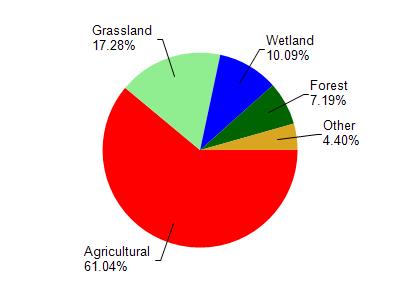Kewaunee
No
No
No
Fish and Aquatic Life
Overview
Casco Creek is a small, clear, springfed stream that flows 10 miles to the Kewaunee River. Its habitat and fishery varies considerably over its length. The 1.4 mile-long segment between the village of Casco and the Kewaunee River has a steep gradient (30 feet per mile), gravel substrate, wooded and well-shaded banks. The 0.4-mile segment near the creek's mouth is a Class I brook trout stream; the remaining mile is a Class II brook trout stream. Public access is limited to one road crossing on this reach. A dam in Casco forms the Casco Millpond. The pond is 1.3 acres, no deeper than 5 feet and does not support a healthy sport fishery due to natural limitations. There is no public access and the pond is not considered to be a significant fishery resource.
The 7-mile stretch above the millpond has a moderate gradient (10 feet per mile) and often flows through wetlands. Some warmwater fishes have been found in the lower two-thirds of this segment. These species include northern pike, rock bass and black bullhead. However, the fish community is mainly comprised of forage species, particularly near the headwaters. Public access is limited to road crossings. Water quality conditions are very good in the stream segment below Casco. The fishery will be further protected when the Casco wastewater treatment plant is upgraded to eliminate residual chlorine. Above Casco, water quality is very good, but heavy siltation from nonpoint sources of water pollution has been noted in many areas. Macroinvertebrates collected in 1984 and 1986 indicated fair to excellent water quality (Nachtwey, 1990).
Date 2001
Author Michael Toneys
Impaired Waters
The 2018 assessments of Casco Creek showed impairment by phosphorus; new total phosphorus sample data exceeded the 2018 WisCALM listing criteria for the Fish and Aquatic Life use. Available biological data did not indicate impairment (i.e. no macroinvertebrate or fish Index of Biotic Integrity (IBI) scored in the "poor" condition category). Based on the most updated information, this water was proposed for the impaired waters list.
Date 2017
Author Ashley Beranek
Condition
Wisconsin has over 84,000 miles of streams, 15,000 lakes and milllions of acres of wetlands. Assessing the condition of this vast amount of water is challenging. The state's water monitoring program uses a media-based, cross-program approach to analyze water condition. An updated monitoring strategy (2015-2020) is now available. Compliance with Clean Water Act fishable, swimmable standards are located in the Executive Summary of Water Condition in 2018. See also the 'monitoring and projects' tab.
Reports
Management Goals
Wisconsin's Water Quality Standards provide qualitative and quantitative goals for waters that are protective of Fishable, Swimmable conditions [Learn more]. Waters that do not meet water quality standards are considered impaired and restoration actions are planned and carried out until the water is once again fishable and swimmable
Management goals can include creation or implementation of a Total Maximum Daily Load analysis, a Nine Key Element Plan, or other restoration work, education and outreach and more. If specific recommendations exist for this water, they will be displayed below online.
Monitoring
Monitoring the condition of a river, stream, or lake includes gathering physical, chemical, biological, and habitat data. Comprehensive studies often gather all these parameters in great detail, while lighter assessment events will involve sampling physical, chemical and biological data such as macroinvertebrates. Aquatic macroinvertebrates and fish communities integrate watershed or catchment condition, providing great insight into overall ecosystem health. Chemical and habitat parameters tell researchers more about human induced problems including contaminated runoff, point source dischargers, or habitat issues that foster or limit the potential of aquatic communities to thrive in a given area. Wisconsin's Water Monitoring Strategy was recenty updated.
Grants and Management Projects
| Project Name (Click for Details) | Year Started |
|---|
|
|
Monitoring Projects
| WBIC | Official Waterbody Name | Station ID | Station Name | Earliest Fieldwork Date | Latest Fieldwork Date | View Station | View Data |
|---|
| 91600 | Casco Creek | 313020 | Casco Creek - Cth C In Casco | | | Map | Data |
| 91600 | Casco Creek | 10016137 | Casco Creek - 50 Ft. Below R.R. Bridge | 10/31/1978 | 10/30/1986 | Map | Data |
|

Watershed Characteristics
Casco Creek is located in the Kewaunee River watershed which is 142.12 mi². Land use in the watershed is primarily agricultural (61.10%), grassland (17.30%) and a mix of wetland (10.10%) and other uses (11.60%). This watershed has 292.03 stream miles, 540.90 lake acres and 7,312.87 wetland acres.
Nonpoint Source Characteristics
This watershed is ranked High for runoff impacts on streams, Not Ranked for runoff impacts on lakes and High for runoff impacts on groundwater and therefore has an overall rank of High. This value can be used in ranking the watershed or individual waterbodies for grant funding under state and county programs.However, all waters are affected by diffuse pollutant sources regardless of initial water quality. Applications for specific runoff projects under state or county grant programs may be pursued. For more information, go to surface water program grants.